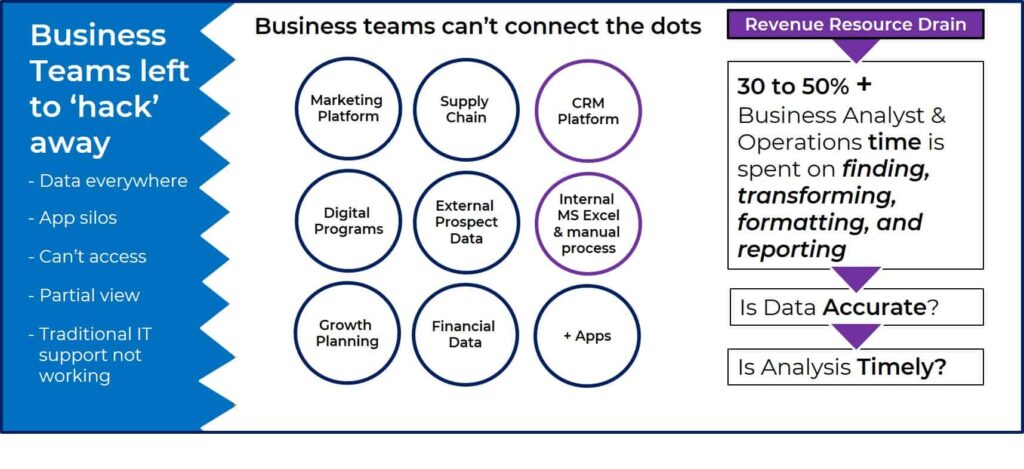5 Tips for Extracting More ROI From Your CRM and Marketing Tech Stacks
Ryan Dudgeon
March 28, 2021

Tech stacks are getting more complicated by the day. Marketing Operations, Revenue Operations, Sales Operations, IT, Analytics, and Executives—we are all doing business using digital automations, including integrations, that allow us to target and interact with our customers and prospects in more meaningful and rewarding ways than ever before.
Take a moment to consider. Are you using a single unified app or platform to strategically grow your revenue? Or are your teams still operating in silos and spreadsheets while losing out on opportunities to make a bigger impact?
If you are like many strategic marketing and revenue leaders, your various specialized sales and marketing technology platforms (MarTech)—Salesforce.com, Marketo, ZenDesk, Sales Loft, and so many more—generate a lot of last-mile data analytics. You have more data and insights, but it can be a struggle to unify it into one big picture. Teams spend so much time doing their best to get that last mile of data to load or to maintain expected week-over-week growth. This leads to more IT projects, longer lead times, more business resources doing integrations or manually inputting spreadsheets, and ultimately burnout or growth slowdown.
You already know bad data can sabotage your business. But good data buried under layers of apps and reports can be just as damaging. Time and resources currently spent on compiling and reporting last-mile data can prevent your business from reaching its full potential and focus your most talented people on poorly identified and prioritized opportunities instead of driving real new revenue channels and targeting the right accounts, roles, and decision-makers.

Here are five tips to find revenue hidden in your tech stacks.
1. Do Not Buy That New Point App or CRM Module Before Getting Your House in Order
Make sure you can adequately answer the following questions before purchasing a new sales or marketing application:
- Is your data squeaky clean, validated, and in the right marketing campaign?
- Are sales teams able to prioritize real leads?
- What is your Ideal Customer Profile?
- Which Job Titles are responding to marketing and sales outreach, then taking meetings?
- Which Job Titles are converting to opportunities? Can you see this in real time across marketing and sales data?
- Do you have a single view of your customer and prospects, including the ability to see customer journey and experience, as a combined view of marketing and sales outreach, and engagement?
- How frequently are you communicating with your top prospects across all channels—email, phone, chat, social media, etc.? Can you analyze that data by touchpoint and across nurture tracks?
- Is the customer and prospect data in your CRM and MarTech systems well-understood, clean, and optimized to match your go-to-market (GTM)?
- Can you measure your KPIs? Are they accurate? And are monitored automatically and easily visualized and reportable to all revenue/marketing leaders so that they can focus on decision-making and you can focus on actions?
If your analysts and operations teams are spending a large percentage of time on manual workloads and entries, such as updating standalone spreadsheets in Microsoft Excel, it is a sure sign that there are opportunities you should pursue to improve your operations before investing in more point applications—such as automating manual work and ensuring the optimization of existing processes inside your CRM and MarTech platforms. That said, it’s true that optimizing your CRM and MarTech stacks can only take you so far. Undoubtedly, some data will never be unified and there will always be a requirement for an outside view. But, there is a huge opportunity for revenue leaders to unify customer data in a modern cloud data analytics platform—mapped to your KPI’s and GTM—to deliver more revenue.
2. See If You Can Save on CRM or Marketing Automation Platform Fees
Once your operational house is in order, look for opportunities to remove unnecessary services and products, such as:
- CRM storage fees for older data, or data you do not need. Offload to your unified analytics platform, where storage is typically much less expensive in self-service cloud-based utilities.
- CRM platform consulting fees and platform fees. Avoid these costs with self-service analytics, using a unified analytics platform.
- MarTech platform and other app cost reduction or avoidance due to optimized automation and management of customer data.
3. Double Down on One Big Thing
Focus on one big thing that will have the largest impact across your people, your processes, and how you go to market using your MarTech stack. For example, you may be able to make a larger impact with an end-to-end program which includes data cleansing, data validation, tight personas, and a customer journey mapped for the new program/sales experience.
4. Feed Your CRM and MarTech Properly
That means good data, real-time leads, and integrated information so frontline sales and customer engagement teams have a prioritized daily list of activities, including lead and account scores that allow simple sorting in CRM reports. Share persona-mapped leads and have Program-Priority, or ‘Sales Play,’ categorized for easy handling. A centralized Revenue Operations or Marketing Operations analyst or team running automations can eliminate duplicated efforts and ensure the best data route to the correct territory and appropriate sales representative.
5. Redirect Your Resources
Now that you know your ideal customer and are saving time, money, and effort by streamlining CRM, MarTech platforms, tech services, data gathering, and analytics, it is time to redirect your resources to future revenue generation. Secure strategic funding by presenting your new revenue operations plan based on what is working in the market, supported by your enhanced command of 360-degree data. Continue to measure, improve, and act upon what is most important to your current and prospective customers.
Tackling all these can seem like a huge task. However, it is well worth the effort to ensure your business is ready to take advantage of future opportunities. In the next blog entry in this series, I’ll give you a detailed prescription of how best to address these issues and to streamline your ability to acquire, retain, and expand your customer base in pursuit of revenue optimization. However, if you’re short on patience or time, take a look at our Customer360 Revenue Optimization solution.
Subscribe to the Actian Blog
Subscribe to Actian’s blog to get data insights delivered right to you.
- Stay in the know – Get the latest in data analytics pushed directly to your inbox
- Never miss a post – You’ll receive automatic email updates to let you know when new posts are live
- It’s all up to you – Change your delivery preferences to suit your needs
